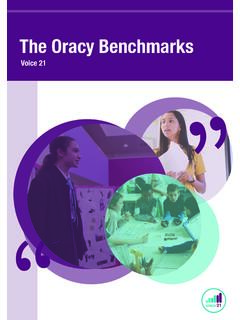Transcription of Thinking for a Change - CCOSO
1 Revised 2/02 Thinking for a ChangeIntegrated Cognitive Behavior Change ProgramJack Bush, & Barry Glick, Ph. D. & Juliana Taymans, program was prepared underauthorization 97-R000 from the NationalInstitute of Corrections, Department of view or opinions stated in thisdocument are those of the authors and do notnecessarily represent the official position orpolicies of the Department of 1997, Bush & Glick & TaymansThe National Institute of Corrections reservesthe right to reproduce, publish, translate, orotherwise use, and to authorize others topublish and use all or any part of thecopyrighted material contained in INSTITUTE OF CORRECTIONSNATIONAL INSTITUTE OF CORRECTIONS ACADEMYTHINKING FOR A CHANGE6#$.'1(%106'065 Lesson 1:Introduction and OverviewLesson 2:Active Listening SkillLesson 3:Asking a QuestionLesson 4:Giving FeedbackLesson 5:Our Thinking Controls How We ActLesson 6:Paying Attention to Our ThinkingLesson 7:Recognizing the Thinking that Leads to TroubleLesson 8:Finding New ThinkingLesson 9:Using Thinking Check InsLesson 10: Knowing Your FeelingsLesson 11: Understanding the Feelings of Others Lesson 12: Responding to the Feelings of Others Lesson 13: Preparing for a Stressful ConversationLesson 14: Responding to AngerLesson 15: Dealing with an AccusationLesson 16: Introduction to Problem SolvingLesson 17: Step 1 Stop and ThinkLesson 18: Step 2 Problem DescriptionLesson 19: Step 3 Getting Information to Set a GoalLesson 20: Step 4 Choices and ConsequencesLesson 21: Step 5 Choose, Plan, Do Step 6 EvaluateLesson 22: Self-Evaluation: What Else Do I NeedPROJECT BACKGROUND.)
2 PrefaceIntroduction and Notes to TrainersCognitive Behavior Programs have evolved over the last thirty years, impactedby a variety of theoreticians and practitioners. Much of the seminal work incognitive interventions began with the efforts of Aron Beck (1970's) , Ross andFabiano (1980's), Albert Ellis (1970's), and Bush (1990's). Almost at the sametime, and parallel to the development of the Cognitive Restructuring modalities,a number of social scientists were also exploring Cognitive Skills training, as aform of psycho- social - emotional interventions. Such individuals as Bandura(1970's), Meichenbaum (1980's) Goldstein and Glick (1980's), and Taymans(1990's) developed strategies and curricula to teach skills to skill deficitindividuals. These early pioneers set the foundation and benchmarks for manyof the programs and cognitive behavioral curricula currently developed andimplemented, including those used throughout the criminal and juvenile National Institute of Corrections has offered a training seminar, CognitiveApproaches to Changing Offender Behavior, for the last six years at theirAcademy in Longmont, Colorado, and more recently as cooperative trainingprograms in various locations throughout the country.
3 Essentially, the curriculumwhich was developed by a panel of experts in cognitive behavioral interventionspresented many of the cognitive restructuring and cognitive skills concepts in ageneric, yet practical manner. As a result of this ongoing experience, it becameapparent that criminal behavior was more susceptible to pro- social Change whenoffenders were able to intermingle and use the tools from both cognitiveNational Institute of CorrectionsThinking for a ChangeIntroduction and Notes to TrainersP-2 THE CURRICULUM:restructuring and cognitive skills programs. As a result of this learning, theauthors of Thinking for a Change , took on an ambitious task to synthesize theconcepts and tools from both cognitive restructuring and cognitive skillsparadigms, into one completely integrated, seamless Thinking for a Change curriculum uses as its core, a problem solvingprogram embellished by both cognitive restructuring and social skillsinterventions.
4 While each of the concepts are presented systemically, theparticipant quickly learns and appreciates that cognitive restructuring doesrequire some cognitive skills methods, as does cognitive skills require anobjective, systematic approach to identifying Thinking , beliefs, attitudes, andvalues. As depicted in the Program Outline, the cognitive restructuringconcepts are introduced and emphasized during the initial eleven lessons of theprogram, interspersed with targeted critical social skills which support thecognitive restructuring process. This is followed by the problem solvingtechniques (lessons 16-21), again supported by appropriate social skills toembellish that concept. Simultaneously, the problem solving portion of thecurriculum relies heavily upon the restructuring concepts and techniques alreadyintroduced to the participants, thereby integrating all three approaches.
5 By thetime participants reach the 12th lesson of the program, the cognitive restructuringtechniques are so ingrained in their repertoire of competencies, that it is nolonger required to be emphasized as a separate entity, becoming "secondnature" to the offender participant. By the 22nd lesson, participants are readyto evaluate themselves using a skills checklist, in order to develop their owncognitive skills (advanced) Institute of CorrectionsThinking for a ChangeIntroduction and Notes to TrainersP-3 CURRICULUM FORMAT: Thinking for a Change is comprised of 22 lessons with a capacity to extend theprogram indefinitely, depending upon how many cognitive skills are taught. Itis recommended that the group meet for an additional ten sessions which isbased upon the self evaluations each participant completes in the 22nd additional skills are the result of further assessment of the skill deficits foreach participant, and then aggregated across the group.
6 In this way, eachgroup member is invested and empowered to participate in their own learningand self development, providing a forum for continued skill and lesson is formatted similarly. It begins with a summary and rationalesection in which the scope, breadth, and reason for teaching the lesson areprovided. This is followed by concepts and definitions, which outline the keypoints of the lesson and any definitions necessary for the trainer to facilitate thelesson. The lesson objectives are then outlined, followed by major activities inthe lesson. Any supplemental material , equipment and materials are listed. The content of the lesson is then each lesson, there are both suggested trainer scripts in which at least thefundamental and required information is provided. There are also specifictrainer notes given in parallel columns which further embellish the training Institute of CorrectionsThinking for a ChangeIntroduction and Notes to TrainersP-4 DELIVERY:The following icons are used to highlight key areas of each lesson:Indicates trainer statements, and suggested scriptIndicates material which should be transferred to chart paper.
7 Indicates overhead transparencies for group Homework section of the each lesson has been planned to be completed within a weekly groupsession (about one to two hours in duration), the curriculum is designed to beflexible and meet individualized program needs. As such, should a lesson needto be extended beyond one week or a two hour time period, suchaccommodations can be made with little operational curriculum has been designed so that any staff person may facilitate groupsand teach its content. No special credential or level of education is should be caring, like to teach, understand group processes andinterpersonal interactions, and be able to control an offender group. It is stronglyrecommended that group facilitators be trained in the content and process ofNational Institute of CorrectionsThinking for a ChangeIntroduction and Notes to TrainersP-5 Thinking for a Change . As such, training for group facilitators should beincluded in any management implementation plan for this program.
8 Trainingshould be accomplished within three to five days with two master participants (offenders) should be pre-screened and selected after a briefindividual interview. Such a meeting which need take no more than fifteenminutes, should set the tone of the learning sessions, direct and focus theparticipant to their need for the program, and an expectation that positiveparticipation would greatly enhance their options, even if they are in a prison orjail program should also have established group norms and expectations. While these may be based upon the individual institutional or agency policy, thegroup norms should consider the learning environment and insure the safety andsecurity for all involved. As such, the group facilitator should consider thefollowing as minimal group norms: Physical Plant insure the room is well lit, ventilated, and chairs arrangedin a comfortable discussion type format (circle; u-shaped tables with chairs;or something similar.)
9 Confidentiality All information shared in the group setting should be keptwithin the group, unless such information is illegal, harms the individualor others. Respect what is shared All statements should be accepted as informationfor learning purposes. As such, individuals should insure that opinions andstatements shared are constructive for the purpose of meeting theobjectives of the lesson and content of the Institute of CorrectionsThinking for a ChangeIntroduction and Notes to TrainersP-6 CURRICULUM FORMAT: Take turns speaking and sharing individuals need to speak one at a time,listening to what is being said, remaining focused on the topic and subjectmatter. No aggression or violence Physical or verbal aggression and violence isnot , as a trainer you must be familiar with the contents of this trainers have different styles and approaches to content delivery, all mustknow the content which must be imparted. Trainers should review each lessonand prepare its contents before each session.
10 Be sure to have all materialsduplicated, handouts ordered, overheads and equipment in good operationalpeak performance, modeling displays well rehearsed, and physical plant set. As you begin Thinking for a Change , the goal is clear: to effect Change inthinking so that behavior is positively impacted. Good luck as you embarkon this most challenging GlickJuliana TaymansJack BushSteve SwisherSUMMARY AND RATIONALE:CONCEPTS AND DEFINITIONS:1 Introduction -- Thinking for a ChangeThe lesson begins by introducing each member of the group to everyone the main idea behind Thinking for A Change is presented: We can takecharge of our lives by learning more effective ways of Thinking . Then 3 brief skitspresent the three cognitive perspectives represented in the program: cognitiverestructuring, problem solving, and social skills. Finally, a course outline isprovided as a handout and the rules and expectations governing participationare presented and briefly major objective is to begin Thinking for a Change in a way that is fun andengaging for participants.




